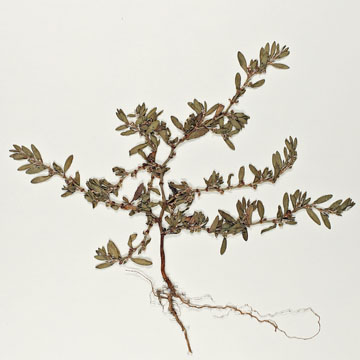

Polygonum buxiforme - (image 1 of 5)
Taxonomy
Family: Polygonaceae
Synonymous with Polygonum aviculare L. ssp. buxiforme (Small) Costea & Tardif
Habitat
Sandy soils bordering marshes, beaches, and dunes, disturbed areas, sidewalks.
Associates
Distribution
Rare but widespread in the United States and Canada, absent from most states of the southeastern Atlantic and Gulf Coasts.
Morphology
Homophyllous, freely branched annual; stems prostrate, mat-forming; leaves oblong to oblanceolate, 3-20 mm long and 1-8 mm wide; ocreae to 5 mm, hyaline-silvery distally; pedicels barely exsert; mature perianth 2-3 mm, divided to below the middle, the undivided part asymmetric, ventricose on one side, the segments greenish with white or pinkish margins; outer 3 segments cucullate; achenes 2-2.8 mm, included, dark brown, minutely striate-papillose, one side broader; late-season fruits exsert, to 4.5 mm, olivaceous, smooth.
Notes
Flowers late July to early October
Wetland indicator: NA
Similar to P. aviculare but the outer three tepals cucullate and longer than the two inner ones; in P. aviculare the three outer tepals are more or less flat and about the same length as the inner ones.
References
Gleason, Henry A. and A. Cronquist. 1991. Manual of Vascular Plants of Northeastern United States and Adjacent Canada. Second Ed.
The New York Botanical Garden. Bronx, NY
New York Natural Heritage Program. Small's Knotweed Guide. http://www.acris.nynhp.org/guide.php?id=9217
USDA, NRCS. 2002. The PLANTS Database, Version 3.5 (http://plants.usda.gov).
National Plant Data Center, Baton Rouge, LA 70874-4490 USA.
|
Michael Hough © 2018 |